Techno-Economic Analysis of Renewable-Energy-Based Micro-Grids Considering Incentive Policies
Abstract
:1. Introduction
- Tackling the incentive policies of the governments in the optimal planning problem formulation of grid-connected RES-based MGs;
- Determining the optimum size of the RES-based MG’s components considering three new incentive policies;
- Investigating the social, economic, and technical impacts of grid-connected RES-based MGs in developing countries;
- Proposing a strategy for implementing incentive policies in commercial software.
2. System Modeling
2.1. System Components Modeling
2.1.1. Solar Photovoltaic Panel Modeling
2.1.2. Diesel Generator Modeling
2.1.3. Battery System
2.1.4. Converter
2.2. Economical Modeling
2.2.1. Net Present Cost
2.2.2. Total Annualized Cost
2.2.3. Renewable Fraction
2.3. CO2 Emissions Calculation
3. Input Data
3.1. The Solar Radiation
3.2. Load Consumption
3.3. System Description and Requirements
- To generate more electricity, 10 batteries are connected in series, forming a battery string.
- The batteries’ initial and minimum SOCs are set to 100% and 40%, respectively.
| Item | Specification | Item | Specification |
|---|---|---|---|
| Minimum load ratio (%) | 30 | |
| Model | MF100-EC4 | Lifetime | 15,000 h |
| Rated power | 250 kW |
| |
| Capital cost (USD) | 7300/kW | Type | Surrette-6CS25P |
| Replacement cost (USD) | 2974/kW | Capital cost (USD) | 1229/single cell |
| O&M cost (USD) | 10/year | Replacement cost (USD) | 1229/single cell |
| Temperature coefficient | −0.5%/°C | O&M cost (USD) | 10/year |
| De-rating factor (%) | 80 |
| |
| Lifetime | 25 years | Type | Leonics GTP519S |
| Rated power | 900 kW | |
| Type | Perkins | Capital cost (USD) | 300/kW |
| Rated power | 250 kVA | Replacement cost (USD) | 300/kW |
| Capital cost (USD) | 500/kW | O&M cost (USD) | 10/year |
| Replacement cost (USD) | 500/kW | Efficiency (%) | 90 |
| O&M cost (USD) | 0.03/hours | Lifetime | 10 years |
| Selling Energy Cost (USD/kWh) | Buying Energy Cost (USD/kWh) | |
|---|---|---|
| Off-peak | 0.16 | 0.0011 |
| Normal | 0.16 | 0.0047 |
| Peak | 0.16 | 0.0155 |
3.4. System Control and Constraints
- The project lifetime is considered as 10 years with an annual discount rate of 18%, and an inflation rate of 19% [51].
- The system’s fixed capital cost and fixed O&M cost are considered as USD 10,000 for the entire project, and 10 USD/year, respectively.
- A maximum annual capacity shortage restriction is established throughout the simulation process. This value is set to 0 to assess the system’s ability to deliver peak demand even in the event of a short fault or interruption.
- The penalty for CO2 pollution is considered 50 (USD/t).
- The discharge efficiency is assumed to be unity.
- The operational reserves are defined as 10% of hourly loads and 25% of PV output.
4. Simulation Results
- The technical features of PV panels, DGs, batteries, and converters, as well as their O&M and capital costs, are fed into HOMER software as input data.
- One of the incentive policies is chosen.
- Various sizes of the components are defined as a search space for the problem.
- An optimum solution is determined by utilizing the following data: temperature data, daily average solar radiation with the clearness index, system constraints and project economics, project lifetime, the main grid parameters, total load, and sensitivity variables.
- Optimization is completed for a different combination of devices.

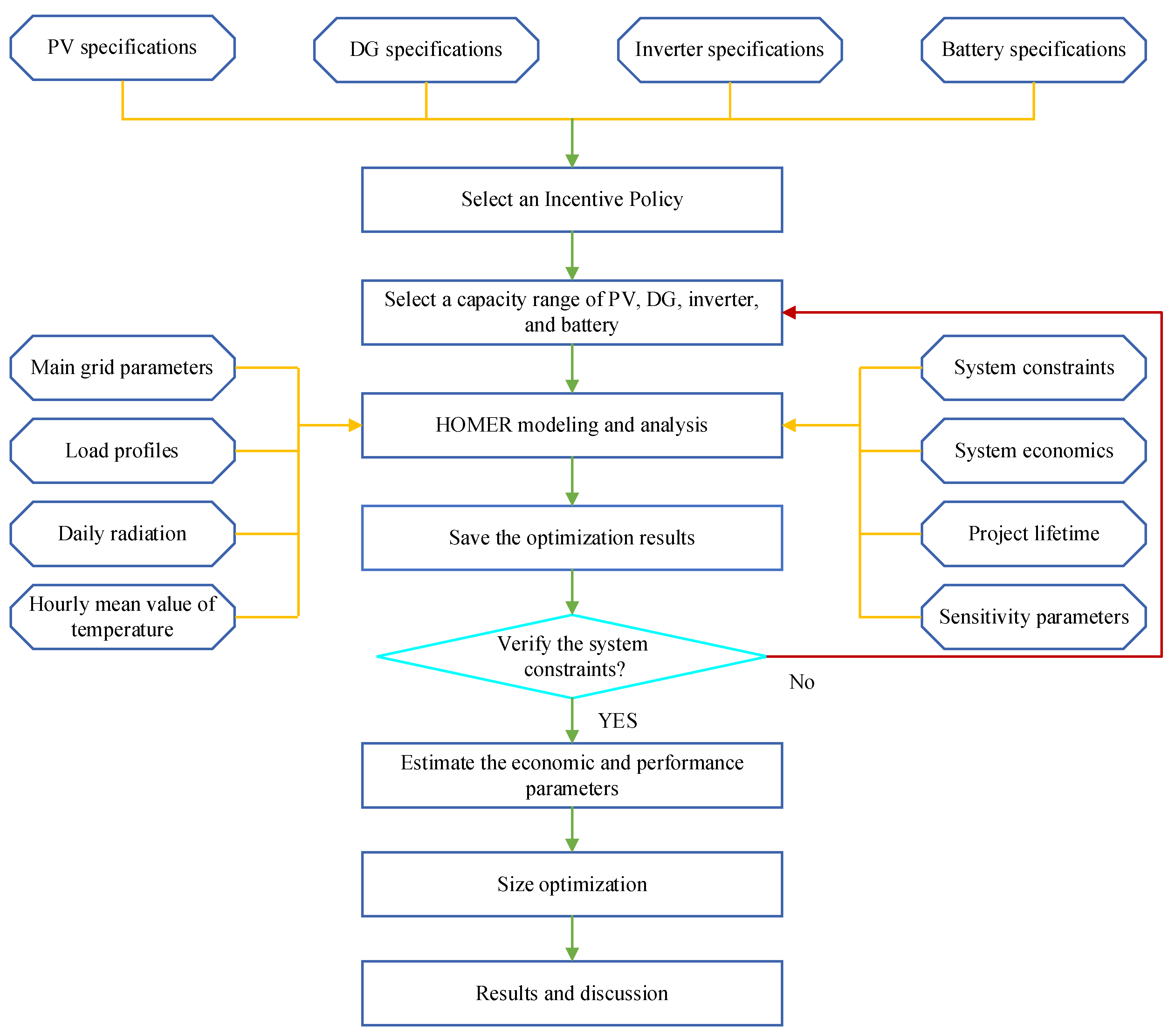
4.1. Results of the MG Design without Considering Incentive Policy
4.1.1. Base Case
4.1.2. The Base Case with at Least 20% Penetration Rate of RESs
4.1.3. The Base Case with at Least 40% Penetration Rate of RESs
4.2. Incentive Policies’ Results
- A.
- Reducing the investment cost of MG equipment;
- B.
- Increasing the price of selling energy by the MG to the main grid;
- C.
- Reducing the price of purchasing energy by the MG from the main grid.
4.3. Discussion
5. Uncertainty in Key Variables
6. Conclusions
- The case with an incentive policy for the investment cost of the MG’s resources has the maximum impact on the NPC reduction.
- The maximum CO2 and NPC reduction occurred in the case of reducing the investment cost of the MG’s equipment.
- The sensitivity analysis results, carried out based on a variation of some parameters, including the expected inflation rate, the PV lifetime, DG fuel price, and optimal reserve show a significant influence of the nominal discount rate, expected inflation rate, and PV lifetime on the NPC.
- The considering incentive policy for investors has resulted in increasing RES penetration and minimizing the dependence on harmful emissions and fossil fuels. Finally, it should be noted that the present work fails to consider uncertainties in load and weather data, which may affect simulation results. Furthermore, the results for the high penetration of inverter-based sources should consider technical aspects regarding stability rather than the economical perspective.
Author Contributions
Funding
Data Availability Statement
Conflicts of Interest
Nomenclature
| Parameters | ||
| Fuel curve intercept coefficient | [unit/hour/kW] | |
| c | Battery capacity ratio | - |
| PV de-rating factor | [%] | |
| EESS,rated | Nominal energy capacity | [Ah] |
| ESupplied | Total supplied electrical | [kW] |
| Fuel consumption of diesel generator | [kWh/L] | |
| i | Annual interest rate | [%] |
| IBat | Battery current | [A] |
| k | Battery rate constant | [h-1] |
| N | Project lifetime | [year] |
| p(t) | Battery power | [kW] |
| The generator’s rated capacity | [kW] | |
| Total demand of the MG | [kW] | |
| The PV array’s rated capacity | [kW] | |
| Incident radiation at standard test conditions | [kW/m2] | |
| Cell temperature under standard test conditions | [°C] | |
| VBat | Battery voltage | [V] |
| αp | Temperature coefficient of power | [%/°C] |
| ζc | Charging efficiencies | [%] |
| ζd | Discharging efficiencies | [%] |
| Variables | ||
| B | Fuel curve slope | [units/hour/kW] |
| EProduction | Non-RES production | [kWh/year] |
| Q | Total quantity of energy stored at the start of the time step | [kWh] |
| Q1 | Available energy | [kWh] |
| Q1,end | Available energy at the end of Δt | [kWh] |
| Q2 | Bound energy | [kWh] |
| Q2,end | Bound energy the end of Δt | [kWh] |
| QBat | Battery charge | [kWh] |
| QBat,0 | Initial battery charge | [kWh] |
| Qmax | Total capacity of the storage bank | [kWh] |
| Solar radiation incident on the PV array in the current time step | [kW/m2] | |
| PV array temperature in the present time step | [°C] | |
| Δt | Charge/discharge time | [hour] |
| Inverter efficiency | [%] | |
| Decision Variable | ||
| Total annual NPC | [USD/year] | |
| Electrical output of the generator | [kW] | |
| Input power of inverter | [kW] | |
| Output power of inverter | [kW] | |
| Output power from panels | [kW] | |
| Acronyms | ||
| CO2 | Carbon Dioxide | - |
| DG | Diesel generator | - |
| GHG | Greenhouse gas | - |
| LCOE | levelized cost of energy | [USD] |
| MG | Microgrid | - |
| NPC | Net present cost | [USD] |
| O&M | Operation and Maintenance | [USD] |
| PV | Photovoltaic | - |
| RF | Renewable fraction | [%] |
References
- Golpîra, H.; Seifi, H.; Haghifam, M.R. Dynamic equivalencing of an active distribution network for large-scale power system frequency stability studies. IET Gener. Transm. Distrib. 2015, 9, 2245–2254. [Google Scholar] [CrossRef]
- Golpîra, H.; Amini, S.; Atarodi, A.; Bevrani, H. A data-driven inertia adequacy-based approach for sustainable expansion planning in distributed generations-penetrated power grids. IET Gener. Transm. Distrib. 2022, 16, 4614–4629. [Google Scholar] [CrossRef]
- Minh, Q.N.; Oad, A. Edge Computing for IoT-Enabled Smart Grid: The Future of Energy. Energies 2022, 15, 6140. [Google Scholar] [CrossRef]
- Bahramara, S.; Moghaddam, M.P.; Haghifam, M.R. Optimal planning of hybrid renewable energy systems using HOMER: A review. Renew. Sustain. Energy Rev. 2016, 62, 609–620. [Google Scholar] [CrossRef]
- Baruah, A.; Basu, M.; Amuley, D. Modeling of an autonomous hybrid renewable energy system for electrification of a township: A case study for Sikkim, India. Renew. Sustain. Energy Rev. 2020, 135, 110158. [Google Scholar] [CrossRef]
- Sadeghi, D.; Naghshbandy, A.H.; Bahramara, S. Optimal sizing of hybrid renewable energy systems in presence of electric vehicles using multi-objective particle swarm optimization. Energy 2020, 209, 118471. [Google Scholar] [CrossRef]
- Kotb, K.M.; Elkadeem, M.; Elmorshedy, M.F.; Dán, A. Coordinated power management and optimized techno-enviro-economic design of an autonomous hybrid renewable microgrid: A case study in Egypt. Energy Convers. Manag. 2020, 221, 113185. [Google Scholar] [CrossRef]
- Mostafaeipour, A.; Qolipour, M.; Rezaei, M.; Goudarzi, H. Techno-economic assessment of using wind power system for tribal region of Gachsaran in Iran. J. Eng. Des. Technol. 2020, 18, 293–307. [Google Scholar] [CrossRef]
- Chambon, C.L.; Karia, T.; Sandwell, P.; Hallett, J.P. Techno-economic assessment of biomass gasification-based mini-grids for productive energy applications: The case of rural India. Renew. Energy 2020, 154, 432–444. [Google Scholar] [CrossRef]
- Elkadeem, M.; Wang, S.; Azmy, A.M.; Atiya, E.G.; Ullah, Z.; Sharshir, S.W. A systematic decision-making approach for planning and assessment of hybrid renewable energy-based microgrid with techno-economic optimization: A case study on an urban community in Egypt. Sustain. Cities Soc. 2020, 54, 102013. [Google Scholar] [CrossRef]
- Taghavifar, H.; Zomorodian, Z.S. Techno-economic viability of on grid micro-hybrid PV/wind/Gen system for an educational building in Iran. Renew. Sustain. Energy Rev. 2021, 143, 110877. [Google Scholar] [CrossRef]
- Rad, M.A.V.; Ghasempour, R.; Rahdan, P.; Mousavi, S.; Arastounia, M. Techno-economic analysis of a hybrid power system based on the cost-effective hydrogen production method for rural electrification, a case study in Iran. Energy 2020, 190, 116421. [Google Scholar] [CrossRef]
- Ghasemi, A.; Asrari, A.; Zarif, M.; Abdelwahed, S. Techno-economic analysis of stand-alone hybrid photovoltaic–diesel–battery systems for rural electrification in eastern part of Iran—A step toward sustainable rural development. Renew. Sustain. Energy Rev. 2013, 28, 456–462. [Google Scholar] [CrossRef]
- Abnavi, M.D.; Mohammadshafie, N.; Rosen, M.A.; Dabbaghian, A.; Fazelpour, F. Techno-economic feasibility analysis of stand-alone hybrid wind/photovoltaic/diesel/battery system for the electrification of remote rural areas: Case study Persian Gulf Coast-Iran. Environ. Prog. Sustain. Energy 2019, 38, 13172. [Google Scholar] [CrossRef]
- Aghapouramin, K. Techno-Economic Assessment of Hybrid Renewable Energy Systems for Residential Complexes of Tabriz City, Iran. Strat. Plan. Energy Environ. 2022, 41, 99–130. [Google Scholar] [CrossRef]
- Jahangir, M.H.; Mousavi, S.A.; Rad, M.A.V. A techno-economic comparison of a photovoltaic/thermal organic Rankine cycle with several renewable hybrid systems for a residential area in Rayen, Iran. Energy Convers. Manag. 2019, 195, 244–261. [Google Scholar] [CrossRef]
- Goudarzi, S.A.; Fazelpour, F.; Gharehpetian, G.B.; Rosen, M.A. Techno-economic assessment of hybrid renewable resources for a residential building in tehran. Environ. Prog. Sustain. Energy 2019, 38, 13209. [Google Scholar] [CrossRef]
- Ghorbani, N.; Kasaeian, A.; Toopshekan, A.; Bahrami, L.; Maghami, A. Optimizing a hybrid wind-PV-battery system using GA-PSO and MOPSO for reducing cost and increasing reliability. Energy 2018, 154, 581–591. [Google Scholar] [CrossRef]
- Amrollahi, M.H.; Bathaee, S.M.T. Techno-economic optimization of hybrid photovoltaic/wind generation together with energy storage system in a stand-alone micro-grid subjected to demand response. Appl. Energy 2017, 202, 66–77. [Google Scholar] [CrossRef]
- Halabi, L.M.; Mekhilef, S.; Olatomiwa, L.; Hazelton, J. Performance analysis of hybrid PV/diesel/battery system using HOMER: A case study Sabah, Malaysia. Energy Convers. Manag. 2017, 144, 322–339. [Google Scholar] [CrossRef]
- Hafez, O.; Bhattacharya, K. Optimal planning and design of a renewable energy based supply system for microgrids. Renew. Energy 2012, 45, 7–15. [Google Scholar] [CrossRef]
- Das, B.K.; Hoque, N.; Mandal, S.; Pal, T.K.; Raihan, A. A techno-economic feasibility of a stand-alone hybrid power generation for remote area application in Bangladesh. Energy 2017, 134, 775–788. [Google Scholar] [CrossRef]
- Movahediyan, Z.; Askarzadeh, A. Multi-objective optimization framework of a photovoltaic-diesel generator hybrid energy system considering operating reserve. Sustain. Cities Soc. 2018, 41, 1–12. [Google Scholar] [CrossRef]
- Mandal, S.; Das, B.K.; Hoque, N. Optimum sizing of a stand-alone hybrid energy system for rural electrification in Bangladesh. J. Clean. Prod. 2018, 200, 12–27. [Google Scholar] [CrossRef]
- Zhang, W.; Maleki, A.; Rosen, M.A.; Liu, J. Optimization with a simulated annealing algorithm of a hybrid system for renewable energy including battery and hydrogen storage. Energy 2018, 163, 191–207. [Google Scholar] [CrossRef]
- Singh, S.; Singh, M.; Kaushik, S.C. Feasibility study of an islanded microgrid in rural area consisting of PV, wind, biomass and battery energy storage system. Energy Convers. Manag. 2016, 128, 178–190. [Google Scholar] [CrossRef]
- Aykut, E.; Terzi, K. Techno-economic and environmental analysis of grid connected hybrid wind/photovoltaic/biomass system for Marmara University Goztepe campus. Int. J. Green Energy 2020, 17, 1036–1043. [Google Scholar] [CrossRef]
- Gamil, M.M.; Lotfy, M.E.; Hemeida, A.M.; Mandal, P.; Takahashi, H.; Senjyu, T.; Co, L.F.E. Optimal sizing of a residential microgrid in Egypt under deterministic and stochastic conditions with PV/WG/Biomass Energy integration. AIMS Energy 2021, 9, 483–515. [Google Scholar] [CrossRef]
- Abid, M.Z.; Yousif, M.; Ullah, S.; Hassan, M. Design, sizing and economic feasibility of a hybrid PV/diesel/battery based water pumping system for farmland. Int. J. Green Energy 2021, 19, 614–637. [Google Scholar] [CrossRef]
- Ribó-Pérez, D.; Herraiz-Cañete, Á.; Alfonso-Solar, D.; Vargas-Salgado, C.; Gómez-Navarro, T. Modelling biomass gasifiers in hybrid renewable energy microgrids; a complete procedure for enabling gasifiers simulation in HOMER. Renew. Energy 2021, 174, 501–512. [Google Scholar] [CrossRef]
- Barua, A.; Jain, A.K.; Mishra, P.K.; Singh, D. Design of grid connected microgrid with solar photovoltaic module. Mater. Today: Proc. 2021, 47, 6971–6975. [Google Scholar] [CrossRef]
- Ghiasi, M. Detailed study, multi-objective optimization, and design of an AC-DC smart microgrid with hybrid renewable energy resources. Energy 2019, 169, 496–507. [Google Scholar] [CrossRef]
- Ghiasi, M.; Niknam, T.; Dehghani, M.; Siano, P.; Alhelou, H.H.; Al-Hinai, A. Optimal Multi-Operation Energy Management in Smart Microgrids in the Presence of RESs Based on Multi-Objective Improved DE Algorithm: Cost-Emission Based Optimization. Appl. Sci. 2021, 11, 3661. [Google Scholar] [CrossRef]
- Rashid, M.U.; Ullah, I.; Mehran, M.; Baharom, M.N.R.; Khan, F. Techno-Economic Analysis of Grid-Connected Hybrid Renewable Energy System for Remote Areas Electrification Using Homer Pro. J. Electr. Eng. Technol. 2022, 17, 981–997. [Google Scholar] [CrossRef]
- Aziz, A.S.; Tajuddin, M.F.N.; Zidane, T.E.K.; Su, C.-L.; Alrubaie, A.J.K.; Alwazzan, M.J. Techno-economic and environmental evaluation of PV/diesel/battery hybrid energy system using improved dispatch strategy. Energy Rep. 2022, 8, 6794–6814. [Google Scholar] [CrossRef]
- Kalappan, B.; Amudha, A.; Keerthivasan, K. Techno-economic study of hybrid renewable energy system of Metropolitan Cities in India. Int. J. Ambient Energy 2022, 43, 1408–1412. [Google Scholar] [CrossRef]
- Islam, M.R.; Akter, H. Optimal Sizing and Techno-Economic Analysis of Grid-Independent Hybrid Energy System for Sustained Rural Electrification in Developing Countries: A Case Study in Bangladesh. Energies 2022, 15, 6381. [Google Scholar] [CrossRef]
- Dong, C. Feed-in tariff vs. renewable portfolio standard: An empirical test of their relative effectiveness in promoting wind capacity development. Energy Policy 2012, 42, 476–485. [Google Scholar] [CrossRef]
- González, P.D.R. Ten years of renewable electricity policies in Spain: An analysis of successive feed-in tariff reforms. Energy Policy 2008, 36, 2917–2929. [Google Scholar] [CrossRef]
- Chen, W.; Wei, P. Socially optimal deployment strategy and incentive policy for solar photovoltaic community microgrid: A case of China. Energy Policy 2018, 116, 86–94. [Google Scholar] [CrossRef]
- Mondol, J.D.; Koumpetsos, N. Overview of challenges, prospects, environmental impacts and policies for renewable energy and sustainable development in Greece. Renew. Sustain. Energy Rev. 2013, 23, 431–442. [Google Scholar] [CrossRef]
- Zhou, Y.; Wang, L.; McCalley, J.D. Designing effective and efficient incentive policies for renewable energy in generation expansion planning. Appl. Energy 2011, 88, 2201–2209. [Google Scholar] [CrossRef]
- Careri, F.; Genesi, C.; Marannino, P.; Montagna, M.; Rossi, S.; Siviero, I. Generation Expansion Planning in the Age of Green Economy. IEEE Trans. Power Syst. 2011, 26, 2214–2223. [Google Scholar] [CrossRef]
- Zame, K.K.; Brehm, C.A.; Nitica, A.T.; Richard, C.L.; Schweitzer, G.D., III. Smart grid and energy storage: Policy recommendations. Renew. Sustain. Energy Rev. 2018, 82, 1646–1654. [Google Scholar] [CrossRef]
- Brka, A.; Al-Abdeli, Y.M.; Kothapalli, G. Predictive power management strategies for stand-alone hydrogen systems: Operational impact. Int. J. Hydrogen Energy 2016, 41, 6685–6698. [Google Scholar] [CrossRef]
- Golpira, H.; Atarodi, A.; Amini, S.; Messina, A.R.; Francois, B.; Bevrani, H. Optimal Energy Storage System-Based Virtual Inertia Placement: A Frequency Stability Point of View. IEEE Trans. Power Syst. 2020, 35, 4824–4835. [Google Scholar] [CrossRef]
- Golpîra, H.; Román-Messina, A.; Bevrani, H. Renewable Integrated Power System Stability and Control; John Wiley & Sons: Hoboken, NJ, USA, 2021. [Google Scholar]
- Gebrehiwot, K.; Mondal, A.H.; Ringler, C.; Gebremeskel, A.G. Optimization and cost-benefit assessment of hybrid power systems for off-grid rural electrification in Ethiopia. Energy 2019, 177, 234–246. [Google Scholar] [CrossRef]
- Average Weather at Sanandaj. Available online: https://www.accuweather.com (accessed on 13 March 2021).
- Naderi, M.; Bahramara, S.; Khayat, Y.; Bevrani, H. Optimal planning in a developing industrial microgrid with sensitive loads. Energy Rep. 2017, 3, 124–134. [Google Scholar] [CrossRef]
- Sadat, S.A.; Faraji, J.; Babaei, M.; Ketabi, A. Techno-economic comparative study of hybrid microgrids in eight climate zones of Iran. Energy Sci. Eng. 2020, 8, 3004–3026. [Google Scholar] [CrossRef]
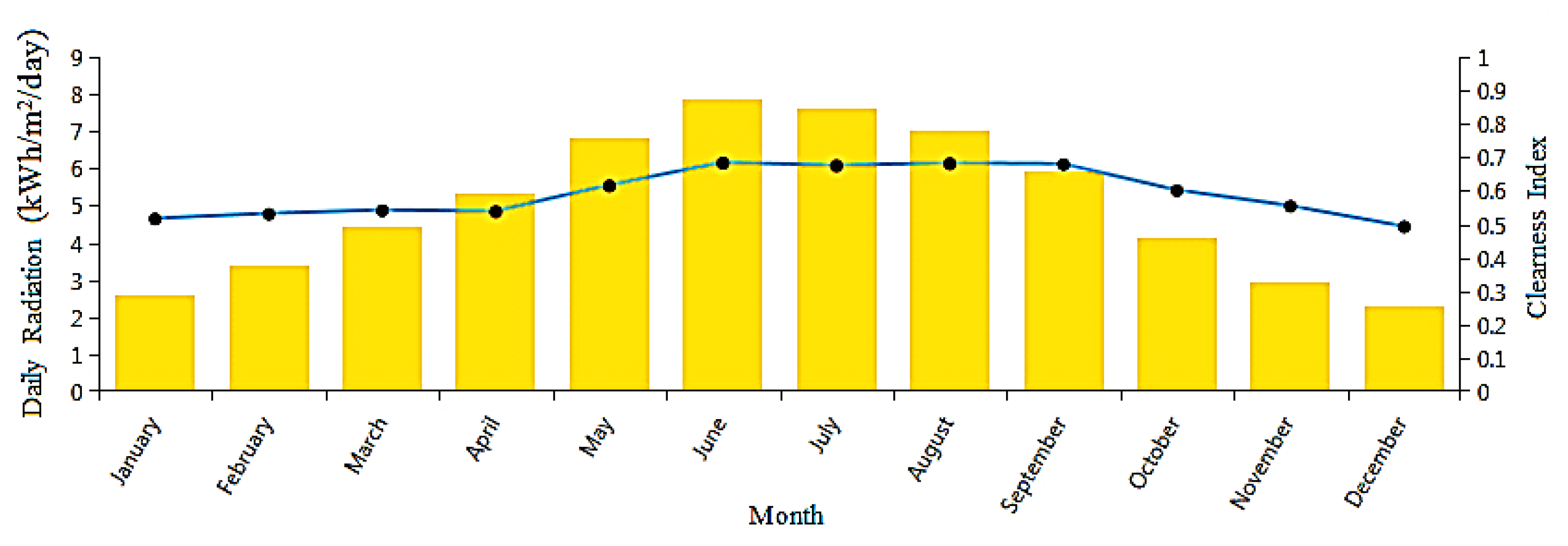

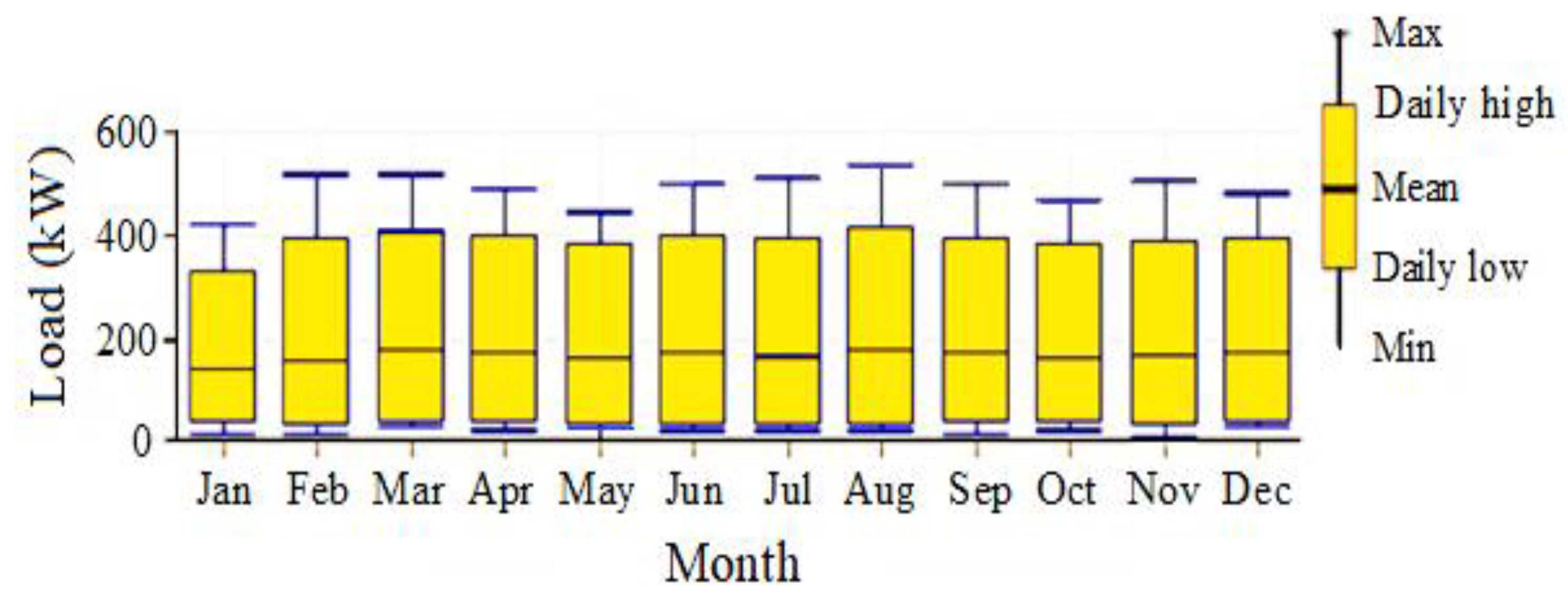

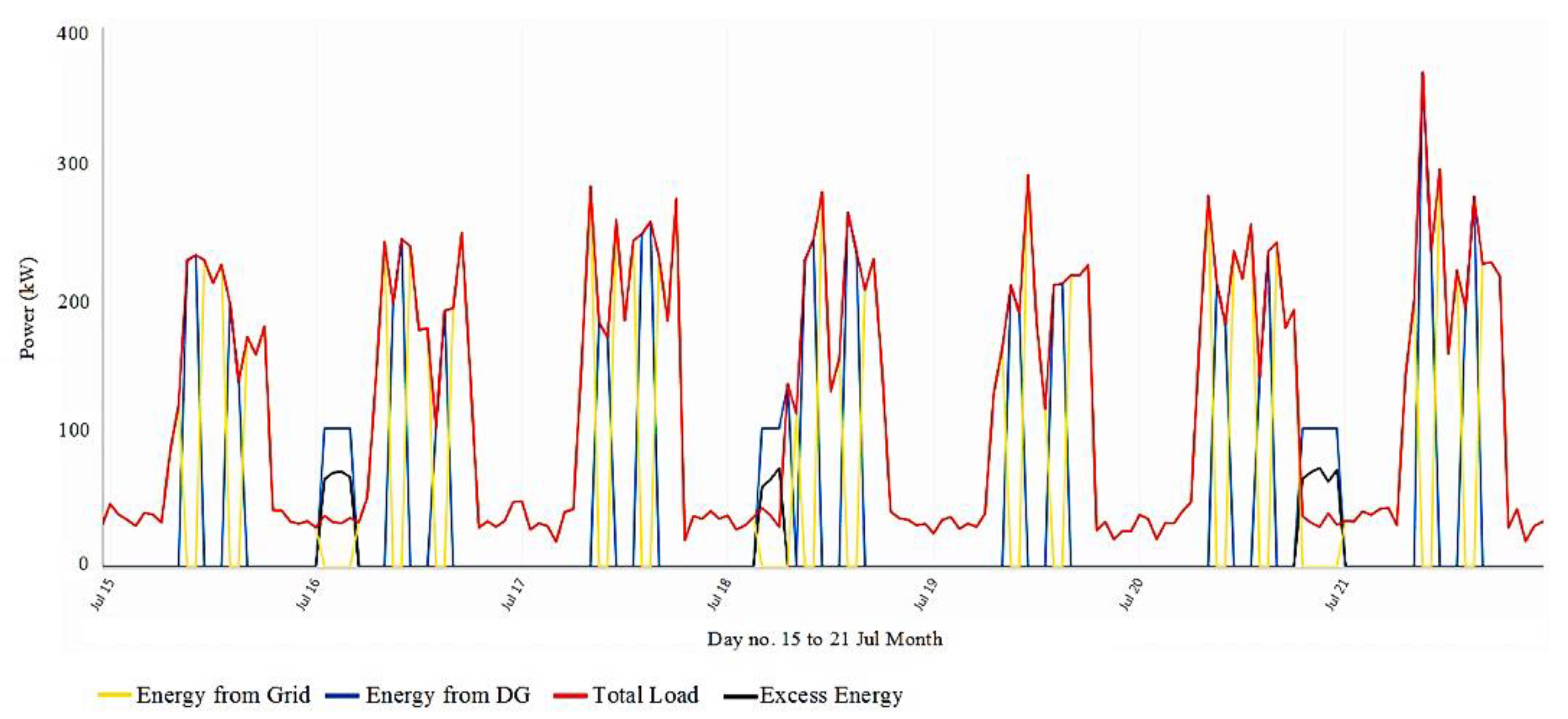
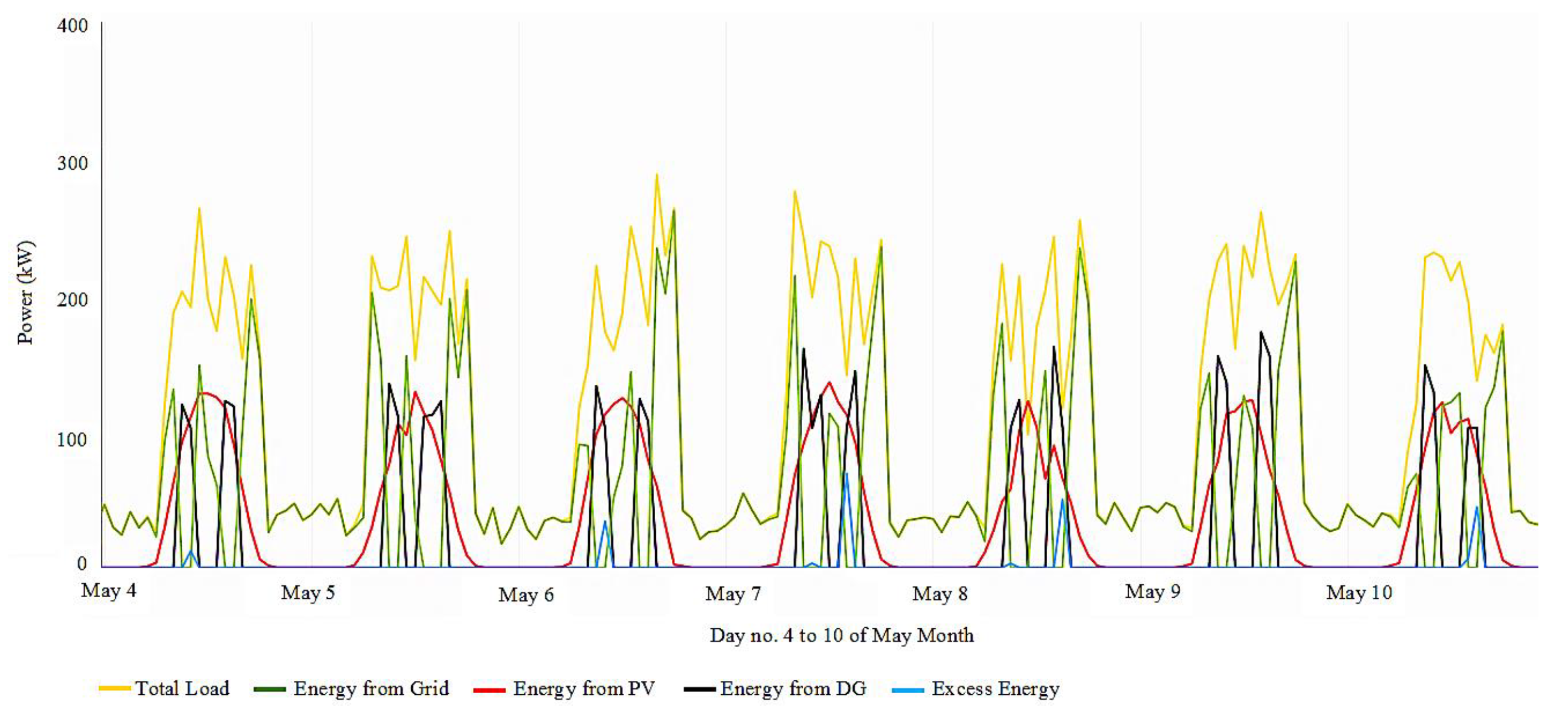

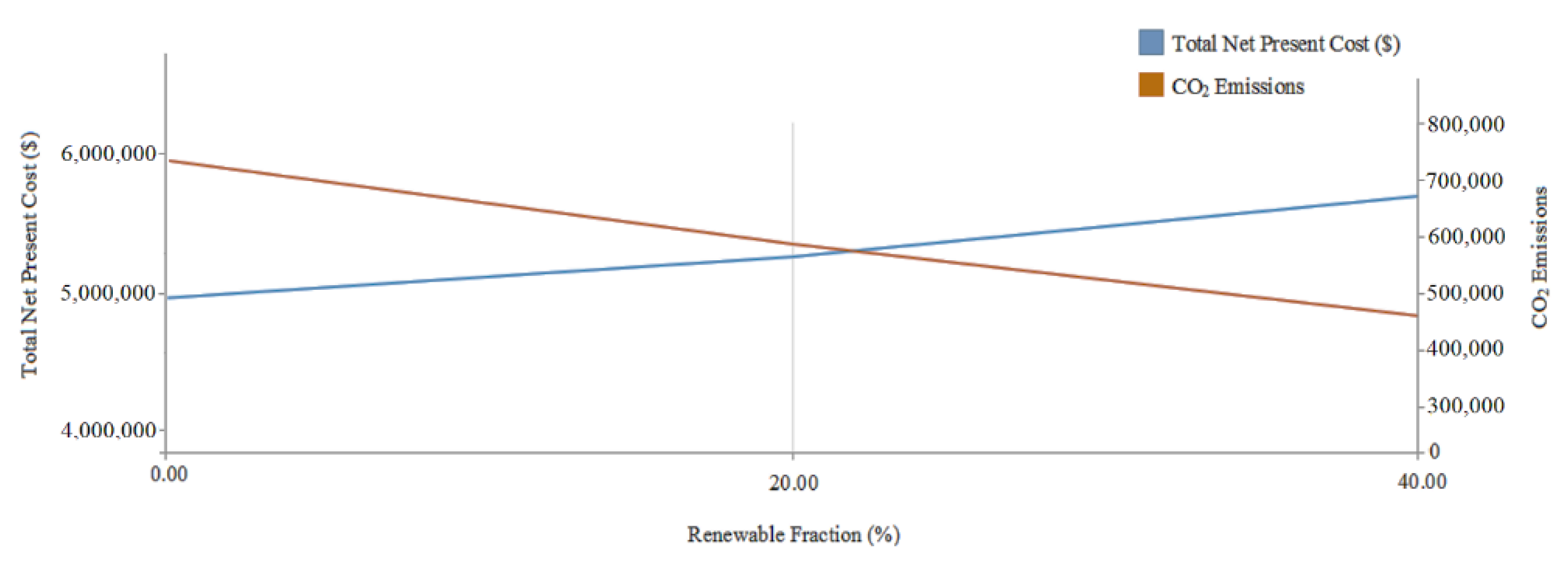


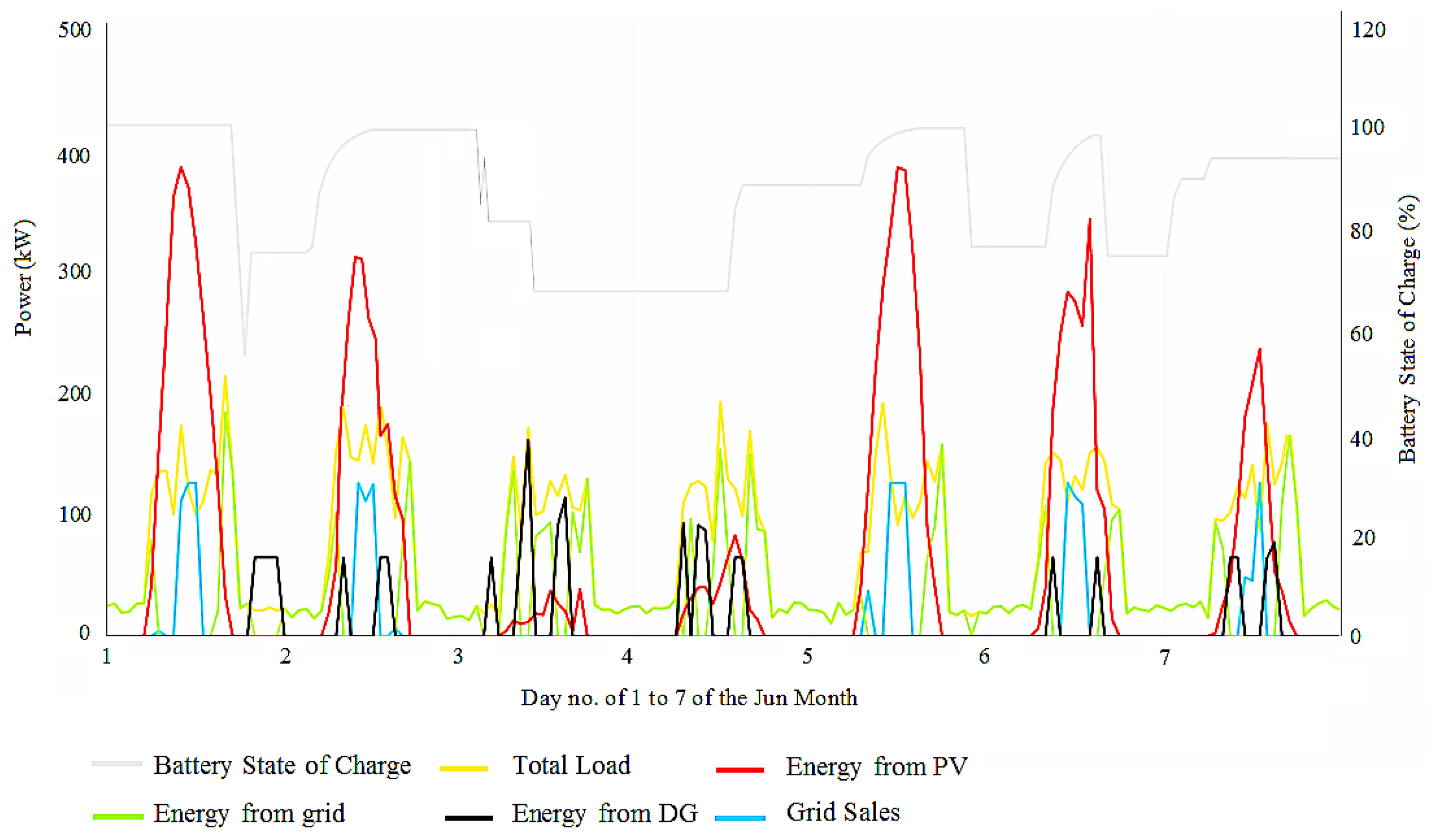
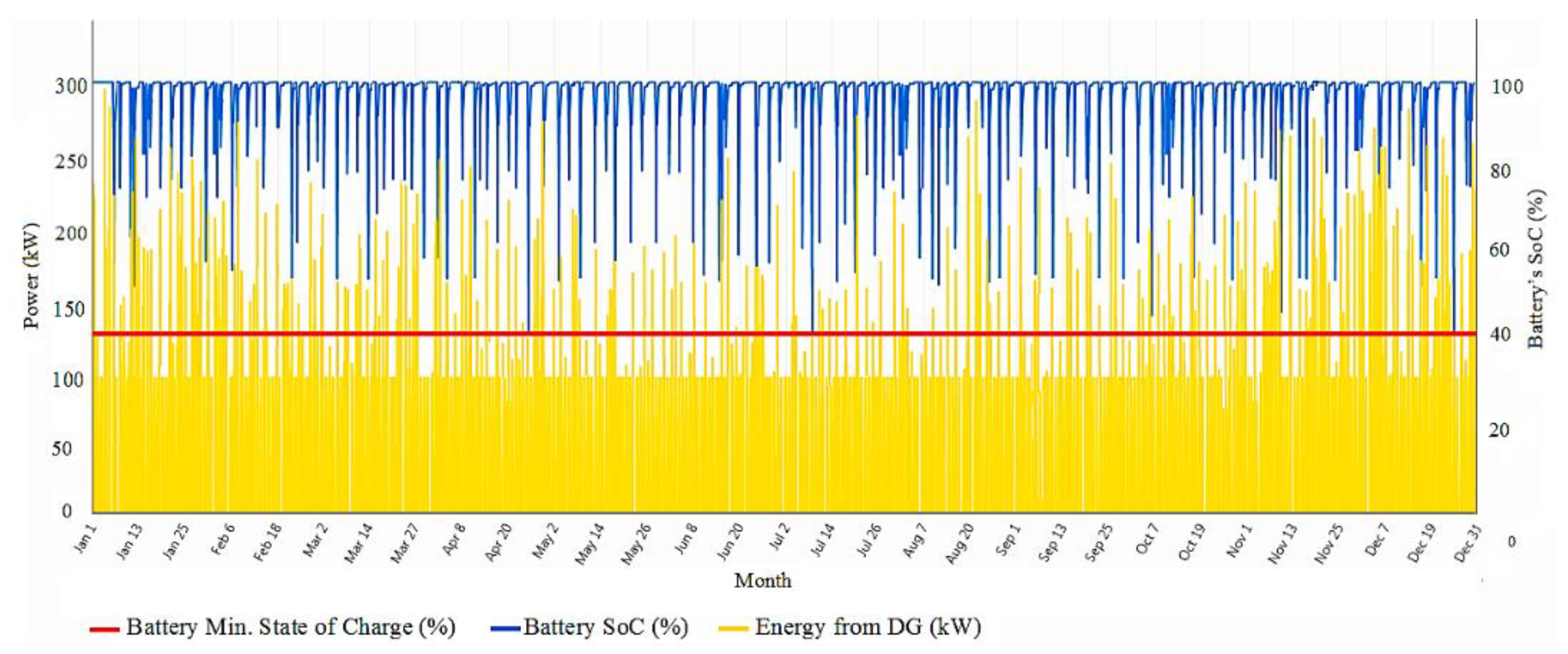

| Ref. | MG Mode | Component | Optimization Tool | Objective Functions | Incentive Policy | |
|---|---|---|---|---|---|---|
| Total Cost Minimization | Pollution Emissions Minimization | |||||
| [18] | Stand-alone | WT/PV/Battery | Genetic algorithm (GA), PSO and multi-objective PSO algorithms, and HOMER software | ✓ | - | - |
| [19] | Stand-alone | PV/WT/Battery | HOMER and GAMS | ✓ | - | - |
| [20] | Stand-alone | PV/DG/Battery | HOMER | ✓ | - | - |
| [21] | Grid-connected/Stand-alone | DG/PV/WT/Micro/Hydro | HOMER | ✓ | - | - |
| [22] | Stand-alone | Biogas generator/PV/DG/WT/Battery | HOMER | ✓ | - | - |
| [23] | Stand-alone | PV/DG | Crow search algorithm | ✓ | ✓ | - |
| [24] | Stand-alone | PV/WT/DG/Battery | HOMER | ✓ | - | - |
| [25] | Stand-alone | PV/WT/Hydrogen storage/Battery | Hybrid chaotic search, harmony search, simulated annealing algorithms | ✓ | - | - |
| [12] | Grid-connected/Stand-alone | PV/WT/Biogas generator/Fuel cell | HOMER | ✓ | ✓ | - |
| [26] | Stand-alone | PV/WT/DG/Biogas generator/Battery | Artificial bee colony (ABC), PSO algorithms, and HOMER | ✓ | - | - |
| [27] | Grid-connected | PV/WT/Biogas generator/Battery | HOMER | ✓ | - | - |
| [28] | Stand-alone | WT/PV/Battery/Biomass generator | Multi-objective GA, epsilon multi-objective genetic algorithm (ε-MOGA) | ✓ | - | - |
| [29] | Stand-alone | PV/Diesel/Battery | HOMER | ✓ | - | - |
| [30] | Grid-connected | PV/Biomass gasifiers/Battery | HOMER | ✓ | - | - |
| [31] | Grid-connected | PV/DG/Battery | HOMER | ✓ | - | - |
| [32] | Grid-connected | PV/WT/Battery | MOPSO and MOGA | ✓ | - | - |
| [33] | Grid-connected | PV/WT/Microturbine/Fuel cell/Battery | Improved differential evolutionary and PSO techniques | ✓ | ✓ | - |
| [34] | Grid-connected | PV/WT/Battery/Fuel cell/Electrolyzer/Hydrogen tank | HOMER | ✓ | - | - |
| [35] | Stand-alone | PV/DG/Battery | HOMER | ✓ | ✓ | - |
| [36] | Stand-alone | PV/WT/Battery | HOMER | ✓ | - | - |
| [37] | Stand-alone | PV/WT/Battery/DG | HOMER | ✓ | ✓ | - |
| This paper | Grid-connected | PV/DG/Battery | HOMER | ✓ | ✓ | ✓ |
| Particulars | Total Energy Consumption (%) |
|---|---|
| Uninterrupted power supply | 35 |
| Air conditioning | 26 |
| Air handling unit | 10 |
| Lighting | 15 |
| Others | 14 |
| Scenario | Grid (kW) | DG (kW) | PV (kW) | Converter (kW) | Energy Storage (n) | Initial Capital (USD in Millions) | Operating Cost (USD/year) | COE (USD) | NPC (USD in Millions) | RF (%) |
|---|---|---|---|---|---|---|---|---|---|---|
| Base case | 600 | 350 | 0 | 0 | 0 | 0.35267 | 187,276 | 0.193 | 4.94 | 0 |
| Scenario | Grid (kW) | DG (kW) | PV (kW) | Converter (kW) | Energy Storage (n) | Initial Capital (USD in Millions) | Operating Cost (USD/year) | COE (USD) | NPC (MUSD) | RF (%) |
|---|---|---|---|---|---|---|---|---|---|---|
| Base case with at least 20% penetration rate of RESs | 600 | 380 | 164 | 248 | 0 | 1.48 | 158,079 | 0.210 | 5.30 | 20.1 |
| Scenario | Grid (kW) | DG (kW) | PV (kW) | Converter (kW) | Energy Storage (n) | Initial Capital (USD in Millions) | Operating Cost (USD/year) | COE (USD) | NPC (MUSD) | RF (%) |
|---|---|---|---|---|---|---|---|---|---|---|
| Base case with at least 40% penetration rate of RESs | 600 | 380 | 362 | 322 | 120 | 3.07 | 129,616 | 0.246 | 5.91 | 40.1 |
| Scenario | RF (%) | CO2 Emissions (kg/year) | COE (USD) | NPC (MUSD) |
|---|---|---|---|---|
| Base case | 0 | 734,498 | 0.193 | 4.94 |
| Base case with at least 20% penetration rate of RESs | 20.1 | 586,959 | 0.210 | 5.30 |
| Base case with at least 40% penetration rate of RESs | 40.1 | 546,175 | 0.246 | 5.91 |
| Plan | Grid (kW) | DG (kW) | PV (kW) | Converter (kW) | Battery (n) | Initial Capital (USD in Millions) | Operating Cost (USD) | COE (USD/kWh) | NPC (USD in Millions) | RF (%) |
|---|---|---|---|---|---|---|---|---|---|---|
| A.1 | 600 | 380 | 164 | 248 | 20 | 1.2 | 129,544 | 0.172 | 4.03 | 20.1 |
| B.1 | 600 | 380 | 164 | 248 | 0 | 1.48 | 128,424 | 0.183 | 4.29 | 20.1 |
| C.1 | 600 | 380 | 164 | 248 | 40 | 1.5 | 128,390 | 0.183 | 4.31 | 20.1 |
| Plan | Grid (kW) | DG (kW) | PV (kW) | Converter (kW) | Battery (n) | Initial Capital (USD in Millions) | Operating Cost (USD) | CoE (USD/kWh) | NPC (USD in Milliona) | RF (%) |
|---|---|---|---|---|---|---|---|---|---|---|
| A.2 | 600 | 400 | 661 | 451 | 140 | 3.17 | 29,182 | 0.144 | 3.81 | 60.8 |
| B.2 | 600 | 410 | 377 | 367 | 80 | 3.09 | 98,270 | 0.217 | 5.24 | 40.2 |
| C.2 | 600 | 410 | 390 | 346 | 0 | 3.05 | 96,068 | 0.217 | 5.26 | 41.0 |
| Case A | Case B | Case C | ||||
|---|---|---|---|---|---|---|
| A.1 | A.2 | B.1 | B.2 | C.1 | C.2 | |
| NPC compared to the base case (%) | −18.42 | −22.87 | −13.15 | +0.06 | −12.75 | +0.06 |
| COE compared to the base case (%) | −10.88 | −25.38 | −0.01 | +12.43 | −0.01 | +12.43 |
| CO2 emissions compared to the base case (%) | −20.8 | −56.13 | −20.8 | −37.39 | −20.8 | −37.99 |
Publisher’s Note: MDPI stays neutral with regard to jurisdictional claims in published maps and institutional affiliations. |
© 2022 by the authors. Licensee MDPI, Basel, Switzerland. This article is an open access article distributed under the terms and conditions of the Creative Commons Attribution (CC BY) license (https://creativecommons.org/licenses/by/4.0/).
Share and Cite
Amini, S.; Bahramara, S.; Golpîra, H.; Francois, B.; Soares, J. Techno-Economic Analysis of Renewable-Energy-Based Micro-Grids Considering Incentive Policies. Energies 2022, 15, 8285. https://doi.org/10.3390/en15218285
Amini S, Bahramara S, Golpîra H, Francois B, Soares J. Techno-Economic Analysis of Renewable-Energy-Based Micro-Grids Considering Incentive Policies. Energies. 2022; 15(21):8285. https://doi.org/10.3390/en15218285
Chicago/Turabian StyleAmini, Shiva, Salah Bahramara, Hêmin Golpîra, Bruno Francois, and João Soares. 2022. "Techno-Economic Analysis of Renewable-Energy-Based Micro-Grids Considering Incentive Policies" Energies 15, no. 21: 8285. https://doi.org/10.3390/en15218285
APA StyleAmini, S., Bahramara, S., Golpîra, H., Francois, B., & Soares, J. (2022). Techno-Economic Analysis of Renewable-Energy-Based Micro-Grids Considering Incentive Policies. Energies, 15(21), 8285. https://doi.org/10.3390/en15218285







